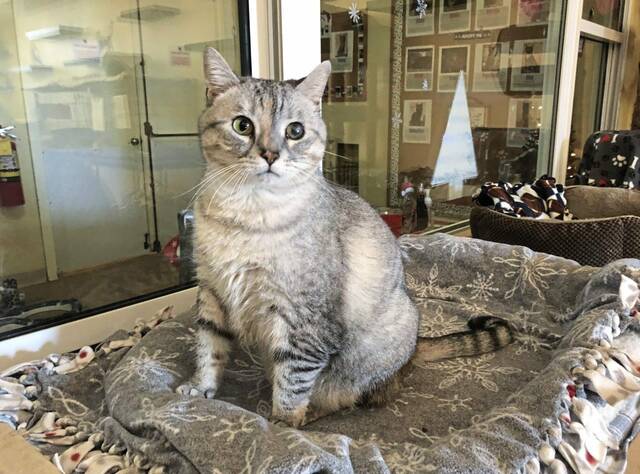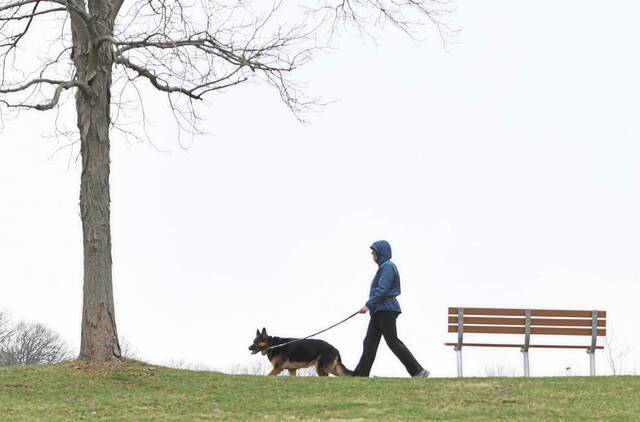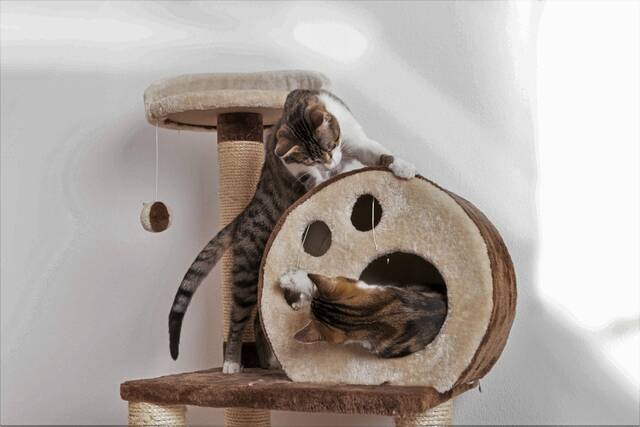Make a New Year's resolution to help your chubby pet lose weight
The new year is approaching and we’ve had our fill of cookies, egg nog and other high-calorie holiday treats. Our pants might be feeling a little tight.
Jan. 1 is usually the day when we start on our New Year’s resolutions to eat healthier, exercise more and lose a few pounds. It might also be a good day to look at Fido or Fluffy and see what kind of shape they’re in.
You probably slipped them an extra treat or two while enjoying your own, and their waistlines might be showing it.
And it’s not just a seasonal issue. As with people, obesity in pets is a — dare we say — a growing problem in the United States. In fact, it might be worse for them than it is for us.
The Centers for Disease Control and Prevention says that, as of 2018, obesity prevalence among Americans was 42.4%.
Here are some even more sobering 2021 statistics from the pet information platform petkeen.com:
• Vets estimate that as many as 59% of all American pets are obese.
• Over the past 10 years, there has been a 169% increase in the number of overweight cats and a 158% increase in the number of overweight dogs.
• As many as 37% of all dogs are overweight by the time they’re 6 months old.
• The risk of obesity in pets increases with the aging of both owner and animal. Overweight owners are more likely to have overweight pets.
• The lifespan of obese pets is 2.5 years shorter on average than their non-obese counterparts.
• Obesity is a major risk factor for certain diseases and causes emotional stress and physical pain in pets.
The eyeball test
A quick eyeball test can help determine if there is cause for concern about your pet’s weight.
The animal should have a clearly defined waist, and its ribs should be easy to feel without being clearly visible. There should be no obvious fat deposits or distension of the abdomen.
If your dog or cat is overweight, a visit with the vet can help rule out physical issues and suggest ways to get rid of the excess.
“The most important thing to do is to talk to a source that is qualified to help you,” said Dr. Michelle Honse, a veterinarian with River Valley Veterinary Hospital in Springdale. “It’s our job to broach the subject, but we do it gently. Believe it or not, most people are pretty straightforward about admitting it when they know their pet has gained weight.”
There can be legitimate reasons why a pet owner isn’t keeping up with a pet’s diet and exercise regimen, such as a change in job, health status or added family responsibilities.
Helping a pet regain a healthy weight comes down to two basic things, Honse said, and it’s the same for cats and dogs: more exercise and less food.
“The paramount thing is to count calories,” Honse said. “Most animals are simply overfed. It’s basic metabolism — if you take in too many calories, you’re going to gain weight.”
Love through food
It wasn’t a New Year’s resolution that put Katie, an American Cocker Spaniel, on a diet — it was a scolding her owners got from their veterinarian.
When Jen and Deb Costello adopted Katie about 5 years ago, the pooch actually was underweight.
That didn’t last long.
Katie came to the Hempfield couple from Deb’s elderly mother, who was no longer able to care for her.
“We showed her love through food,” Jen said. “That was the excuse we used, but it was a bad excuse.”
Nibbles of people food at mealtime, treats at bedtime — and the pounds started to pile on. Health problems exacerbated the situation.
Katie was diagnosed with congestive heart failure, which limited her physical activity, and medication for a stubborn ear infection added to her weight gain.
The dog, now 10, weighed in at about 34 pounds when her owners got that word from their vet.
“The vet lectured us, ‘Listen, you need to cut this out,’ ” Jen said. “We needed to realize that we were enabling her.”
So it was goodbye to the egg yolks and pasta and hello to Fresh Pet grain-free food, vegetables, fruits and lower-calorie treats.
“We also started getting her outside more and getting her moving,” Jen said.
Their efforts have paid off — Katie is down to 26 pounds.
“It took at least a year to get the pounds off, and it took that long for us to change our habits, too,” Jen said. “You gotta learn to say no.”
Empty calories
“Most treats are just empty calories,” said Michael Post, interim shelter manager and medical coordinator at Animal Protectors of Allegheny Valley in New Kensington. “When we see an overweight dog, it’s usually a case of overfeeding them treats.”
Treats have caused trouble for dogs in the Animal Friends of Westmoreland shelter in Youngwood, too.
“The dogs get walked three times a day but, even with that, we ran into a problem with every volunteer coming on at every shift wanting to give them a treat,” said AFW executive director Kelli Brisbane.
Not only was that leading to weight gain, but also to stomach upsets for some of the pooches.
“We had to train (the volunteers) to give them a hug and a kiss and a walk instead of treats,” she said.
Post recommends replacing packaged treats with fruits and vegetables.
As for the shelter cats, Brisbane said, “Obviously, the cats don’t get walked, but we do encourage them to play. But cats like to do what they like to do.”
The cats get wet food in the morning and have kibble available all day in the cattery’s common area.
“If we have a cat with an affinity for eating, we might have to keep them in a cage to keep them from overeating,” Brisbane said.
“You can encourage cats to move more through play with teaser toys and laser pointers,” Post said.
Doggie diets
Here are some weight loss tips from the American Kennel Club:
• Feed your dog his normal morning meal, but replace the second meal with low-sodium green beans, a bit of kibble and a canine multi- vitamin.
• Switch to a healthier treat option. Try replacing biscuits, cheese and other high-fat treats with fresh chopped carrots, apples or green beans without added flavoring. Most dogs like something crunchy.
• If your dog’s training regimen includes treats as a reward, remember to subtract those calories from the daily food allotment.
• Don’t associate feeding with love.
• Remember that most dogs are highly food-motivated and will act ravenous even after being fed.
Kitty calorie counting
A cat’s diet plan can include both cutting calories and increasing movement. VCA Hospitals suggests some ways to do that:
• Move the food bowl to rotating locations around the house, so the cat always has to walk to get to the food.
• Keep the food bowl as far away as possible from your cat’s favorite haunts.
• Invest in feeding balls that a cat must roll around in order to get pieces of food out as a reward. You can also throw their dry food to them to make them chase it at mealtimes.
• Set aside regular times to play with your cat. Use feather toys, laser pointers, paper or foil balls or anything else that your cat will chase. Try to play for 10 minutes twice a day.
Shirley McMarlin is a Tribune-Review staff writer. You can contact Shirley by email at smcmarlin@triblive.com or via Twitter .
Remove the ads from your TribLIVE reading experience but still support the journalists who create the content with TribLIVE Ad-Free.






